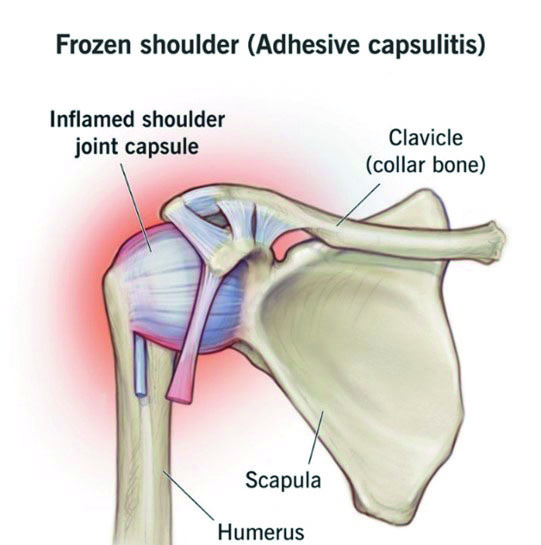DR. KAIWAN RANDERIA
Is your shoulder so stiff it feels like it’s made of cardboard? You might be dealing with Frozen Shoulder – a condition where the capsule of your shoulder joint undergoes inflammatory changes, leading to stiffness in the shoulder joint.
The shoulder is one of the most mobile joints in the human body, allowing you to perform a wide range of activities, from lifting your arm to throwing a ball. The shoulder joint is made up of three main bones – Humerus: The upper arm bone; Scapula: or the shoulder blade – a flat triangular bone located at the back of the shoulder; and Clavicle: or the collarbone – which connects the arm to the body at the sternum (central bone of the ribcage). In lucid terms, the upper end of your humerus (ball) is connected to your shoulder blade (socket) by means of several ligaments and they form a capsule engulfing the joint. When this capsule gets inflamed, we encounter the aforesaid condition of a frozen shoulder.
So, what causes a frozen shoulder in the first place? Though the exact cause has not been ascertained, some Predisposing Factors include:
Age: More common in the 40-60 years’ age bracket
Diabetes: Higher incidence of this condition is seen in people having diabetes; especially in poorly controlled cases.
Thyroid disorders: Patients having hypo or hyperthyroidism have a higher predilection to this condition
Hormonal Changes: Particularly in women during menopause, can increase the risk of frozen shoulder due to changes in collagen and connective tissue.
Genetics: Some people inherit a tendency to develop frozen shoulder, making it more likely.
Other Health Conditions: Such as heart disease and Parkinson’s disease, have been linked to a higher chance of developing frozen shoulder.
Inflammatory conditions: Such as arthritis (especially rheumatoid arthritis), can lead to frozen shoulder by causing swelling and stiffening of the shoulder joint.
Typically, frozen shoulder develops in Four Stages:
- Stage of Synovitis: Symptoms are present for less than 3 months and consist of aching pain on rest and is exacerbated on extremes of shoulder movements.
- Freezing Stage (Painful Stage): In the initial phase, pain gradually increases, especially when moving the shoulder. This stage can last between 3 to 9 months.
- Frozen Stage (Stiffness Stage): After the pain begins to subside, the shoulder becomes progressively stiffer, and movement becomes difficult or even impossible. This stage may last 9 to 14 months.
- Thawing Stage (Recovery Stage): Over time, the shoulder starts to regain its flexibility, and movement gradually improves. This stage can last anywhere from 15 months to 2 years.
Recognizing the Symptoms: The symptoms of frozen shoulder may vary depending on the stage, but common signs include Pain, which often starts as a dull ache and may worsen at night. You experience a Limited Range of Motion, as the condition progresses, becoming increasingly difficult to move the shoulder in any direction. There is also Stiffness, where one feels like their shoulder is ‘locked’ or ‘frozen’, with little ability to move it. If you notice persistent shoulder pain and stiffness, it’s important to consult a healthcare professional to rule out other potential conditions.
Diagnosis: There are a multitude of conditions which can manifest in a similar way and hence, the diagnosis of a frozen shoulder should be done only by an orthopaedician who may assess it clinically or with the aid of medical imaging and tests. A review of symptoms, and sometimes imaging tests, such as X-rays or MRI scans, to rule out other shoulder issues like arthritis, a torn rotator cuff or any underlying infective pathology may also be done.
Treatment: Treatment for a frozen shoulder generally focuses on relieving pain, reducing inflammation, and restoring movement. Common treatment options include:
Physical Therapy: One of the most effective treatments for frozen shoulder is a structured physical therapy program in conjunction with your orthopaedician. A physical therapist guides you through exercises designed to stretch and strengthen the shoulder joint, improving range of motion.
Medications: Nonsteroidal Anti-Inflammatory Drugs (NSAIDs), if medically permitted, can help reduce inflammation and relieve pain during the painful phases. However, these should be taken in moderation and not for long durations.
Joint Injections: In some cases, corticosteroid injections may be injected into the shoulder to decrease inflammation. These usually work well in stages 1 and 2 of frozen shoulder.
Heat and Cold Therapy: Applying heat or cold packs to the shoulder can help reduce pain and improve mobility, especially before physical therapy exercises.
Joint Distension: For some resistant cases, a doctor may inject sterile fluid into the shoulder joint to help stretch(distend) the capsular tissue and make it easier to move.
Surgery: Surgery is rarely necessary, but in cases where other treatments fail to work, procedures like shoulder arthroscopy or manipulation under anaesthesia may be considered to break up scar tissue and restore movement.
While frozen shoulders can be a painful and limiting condition, understanding its causes, symptoms, and treatment options can empower you to take proactive steps toward managing your health. Early diagnosis and seeking medical guidance are key to minimizing the impact on daily life. With the right combination of physical therapy, pain management, and sometimes, less commonly, surgical intervention, most people can recover fully or experience significant improvement. By raising awareness of frozen shoulder, we can help those affected regain mobility and return to a more comfortable, active life.
[Disclaimer: The contents of this article should not be considered as formal medical advice and one should not attempt to self-diagnose. Kindly visit an Orthopaedician for any related treatment.]
- કેવો સુંદર જવાબ! - 29 March2025
- પારસી સન્નારીઓ તેમના જાદુઈ સ્પર્શ સાથે બની સુરત મેરિયોટ અથવા લાઇન્સના રસોડાની રાણીઓ - 29 March2025
- મોબેદ મેહરાબાન ફિરોઝગરીનું અવસાન - 29 March2025
